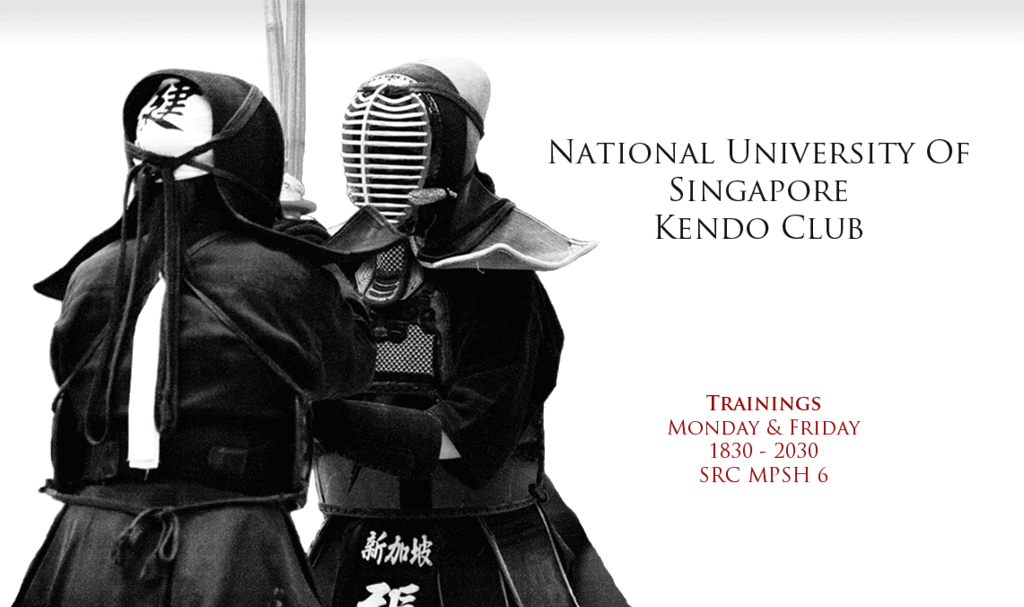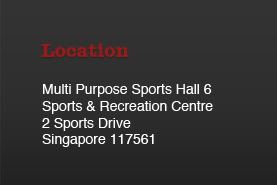Monday, February 21, 2011
1st Joint Training
By Belinda
On the 20th of February 2011, NUS hosted the first joint training initiative by David Yeo sensei. Kendokas from SKC and our affiliate clubs NYP and SMU were invited to join us in MPSH 6 on a Sunday morning to train together.
For NUSKC, joint training allowed us to train under guidance of the numerous senseis from SKC. It was a also wonderful opportunity for us to train alongside and mingle with other kendokas that we often had little chance of meeting, except at kendo events such as tournaments or gradings.
Joint training started off with a Beginner's Class and Japanese training.

Training suburi (cuts)
Followed by ashi-sabaki (footwork) practice


Ki-ai (spirit) practice, followed by suburi


Senseis guiding the children during practice.
Watching the Japanese training was enlightening. Although many of the Japanese kendoka in training were young children, some of them had solid cuts and footwork. They were well on their way to being strong kendoka. It was a reminder to us never to neglect our fundamental kendo training, because how good we are depends very well on how much we've mastered our basics.


Getting ready for kata practice
We then began training for the Advanced Class. The first half hour was on free kata practice, where we practiced with a partner while senseis walked around to correct any mistakes they noticed. Then we proceeded to kihon training, followed by godou keiko (goodwill sparring)
Inoue-sensei giving Kenneth some pointers
[Unfortunately there are no other photos of the advanced class because we were all too busy training!]
Personally, I enjoyed joint training tremendously. Although I found it to be a rather short training, it felt very special to be inside a hall filled from left to right with kendokas. There was a lot to learn, especially from godou keiko. After a long queue I finally got to keiko with Nishida-sensei and it was a very fun--but at the same time VERY CHALLENGING--experience trying to score hits off him. Other highlights for me include doing kote-men for three motodachi (receivers) and back again.
I hope there'll be another joint training soon! (:
13th Youth Kendo Tournament
By Maureen & Nasution
The 13th Youth Kendo Tournament was held on the 22nd and 23rd of January 2011. This year's YKT was hosted by our club, on homeground in NUS. We get Nasution and Maureen to share their experiences.
NASUTION:
Enter NUSKC!
The recent Youth Kendo Tournament was also my very first tournament after being on hiatus for around two years. Naturally, I was nervous before the tournament day. I had not trained as much as the others during the first semester as besides adapting to the severe change in lifestyle, I decided to pick up Muay Thai as well. For me, I do not consider myself to be strong as I have a lot of flaws in my kendo and I’m not consistent.
"What was your experience like fighting for NUS -- Individuals & Team?"
-- for the uninitiated, Nasution used to be from NYPKC.
It was a rather new experience, fighting for a new club with new comrades. For the individuals, you are fighting for no one but yourself so this is the part of the tournament where people are willing to take more risks, myself included. I managed to make it all the way to the quarter finals. For the team event, this is considered to be the more important part of the tournament. This is where you will not only be fighting for your team but your club/school as well. I was the
Senpo and most, if not all, of my matches ended in a draw. “That’s a good thing since you did not lost your matches!” is what a lot of people will say but that is not how I felt. First things first, winning my matches would have imposed less stress to the other 4
kendokas after me. All the points that the opponent got off me could have been prevented as well. I apologise to everyone for not doing a better job.

Best Fighting Spirit Award. I'm quite surprised there's one, seriously..
[But we're not. Nasution you did us proud (:]

NUS A vs SKC B
"How did it feel to meet people you knew from NYP and SKC at the tournament?"As friends? It was great since I have not seen most of them ever since I entered National Service. As opponents? Terrible! That was the initial feeling I had because I have a certain ‘phobia’ about fighting against them--to me, they were considered very strong. It did not help knowing that I had taken a two year hiatus and some of them were still training regularly.
My first match was against Meng Kiat, whom I had a lot of difficulty fighting against due to his height and long reach.
Another one was Wai Kay, who was from my batch and also the captain of the club during our term in NYP. We knew each other's fighting style quite well so after a long while, the match dragged on into enchou (sudden death). On a side note, I have never really gotten into an enchou before and this particular one with Wai Kay proved to be demanding both physically and mentally.
My third opponent was Billy, who was as rough as ever. The last person whom I knew from NYP/SKC that I fought was Kian Chew. He was my junior, but he has been training regularly and has gotten a lot faster, so it was a pretty violent match up.
"Do you have any insights following this tournament?"
I have learnt a lot from this tournament. One of them is my posture. Most of the time my posture would get ugly which makes it more difficult to move around. Oliver told me it took roughly six months to correct his posture so I will do just that for this semester.
As for the club, a lot of my club members have mentioned to me that NUS' kendo style emphasizes more on kihon (fundamentals) rather than competitive shiai and that is the reason why it may be harder for us to defeat an opponent from other clubs. In my opinion, the NUS style is good as without grooming proper basics, it will be more difficult to advance at the later stage of one's kendo growt.
Perhaps instead of thinking "why can't I beat my opponent with my current style?", we could change it to "how can I beat an opponent with my style?".
With that, I will end it with one of my favourite quotes, from Nanoha.
MAUREEN:
21st Jan 2011: Preparation for YKT 2011Preparation was done just one day before the Youth Kendo Tournament 2011.
With the help from everyone (juniors and seniors), we managed to finish the
preparation in no time! c:
Here is a rundown of the events set up for the first day of the tournament.
- Ladies Individuals
- Mens Individuals
- Ladies and Mens Final
- Prize Ceremony

Officials setting up
All of us came around noon to prepare for Day 1 of YKT 2011! *Excited~!
The moment the officials entered the hall, we moved to the table to make sure that
everything we needed was there.
All the medals on display
The intense atmosphere in the dojo was overwhelming. If you were there, you
would definitely feel that everyone was there to earn their place in the tournament.

The shimpans, officials and competitors are lined up to bow to the dojo.
This is a formality that every kendoka is familiar with.

Warming-up before matches is essential
Let the matches begin!

Everyone was focused on watching.
No one wants to miss seeing the points being scored
23rd Jan 2011Day 2 of the tournament involved the following:
- Ladies' Team Eliminations
- Mens' Team Eliminations
- Ladies and Mens' Team Finals
- Prize Ceremony
Day 2 started early, at around 7-8am--many of us were tired BUT the atmosphere for Day 2
was much more intense than Day 1! This time round the competitors were fighting for their
respective teams, which meant that there was much more to lose.

Our NUS Men's Team B is chilling by the side
In all, we would like to thank everyone that came for this year's Youth Kendo Tournament. Without everyone, YKT 2011 would not have been this successful.
AWESOME TOURNAMENT! C:
9th ASEAN Kendo Tournament
By Belinda
The 9th Asean Kendo Tournament was held on the 23rd to 24th of October 2010. This year's AKT was hosted by Singapore and had participants from Thailand, Vietnam, Malayia, Brunei and Indonesia.

March-in of the tournament participants
Many of our shimpans also took the time to come to Singapore from overseas!
The NUS Kendo Club was proud to have our very own members representing Singapore in the men's national team! Yong He, Wenhao, Zehao, Gervinn, and Cheefung trained very hard for almost half a year leading up to the actual tournament.
Team Singapore (:
Of course, every kendo tournament requires manpower to help keep it running smoothly. Many of us volunteered to help out in running the event, together with fellow kendokas from SKC, NYP and SMU. We were tasked to help out in court official roles such as court managers, taggers, time-keepers and time-keepers.
Setting up the courts
It's early in the morning but we're all ready for the matches to begin!
For most of us, it was our first time carrying out these roles. Although we had some prior experience in running tournaments with our NUS Championship Series, it could not possibly compare to one on such a grand scale as AKT.
Prior to the actual tournament, we held two dry runs on weekends to pre-empt any possible problems and to simulate the flow of the event. During these, we learnt many details that we had to pay careful attention to. Court officiating was highly meticulous! Some of the many things we were taught by senseis and senpais included how to properly fold the shimpan flags, present scores on the scoreboard, and even the correct method to tag a kendoka.
As a tagger on the actual day, I was both nervous and excited to be a court official.
Proud to be a part of AKT!
In a round-robin playoff, as was planned, the fighters on court often changeover very quickly--but that would mean that we had to tag them just as rapidly! Sometimes, we had to change tag colors in split seconds. Thankfully we managed all that with plenty of teamwork between the three taggers we had for each court :)
Many of our international friends were new to the courts in SKC, and we also had to help direct them to the right areas before their matches. Often, they too were nervous (or just really tired after their tough matches!). We had to make sure that we did not give them the wrong information. We would remind them when their next match was, and what colour they were tagged. If they had queries, they usually came to us too, such as asking who their opponent was or when the team could make changes to their line-up.
Shannon's tare--unfortunately he is fighting for Malaysia
Another difficulty that we faced was having to identify the right person to tag! Since we didn't know our international visitors by their faces, we would often run around with tags in our hand, our eyes desperately combing the many kendokas' tare in search of the number we had to tag. By the second day, we were actually able to associate some kendokas' faces with their tare numbers.
Although tagging was tiring and potentially nerve-wrecking, it was a great way to get up close and personal to the matches. Exciting matches were fought right before our eyes and when we had the chance to watch, they often blew us away. There were many new techniques and styles of fighting that we could observe, such as how to fend off a jodan-player. As I watched our Women's team triumph their way to the finals, I was also very inspired by how strong they were (:
Some videos
Thrilling match between Singapore (red) and Thailand (white).
Both teams have drawn after the team round-robin playoff. One player from each team has been chosen to battle it out, and the winner of the first point will determine which team will proceed to the semi-finals. Suresh takes the point for Singapore after an intense battle! The crowd goes wild... myself included.

Godou (goodwill) keiko at the end of each day
In all, I'm very grateful to have been a part of AKT. It has been a wonderful opportunity to watch high-level kendo, meet international kendokas and keiko with them, and of course, learn how to run a tournament. :)






























